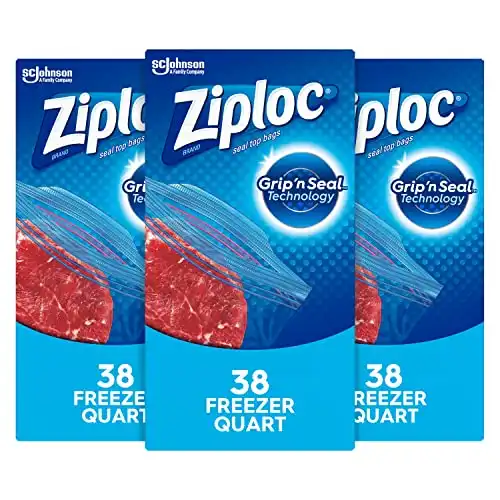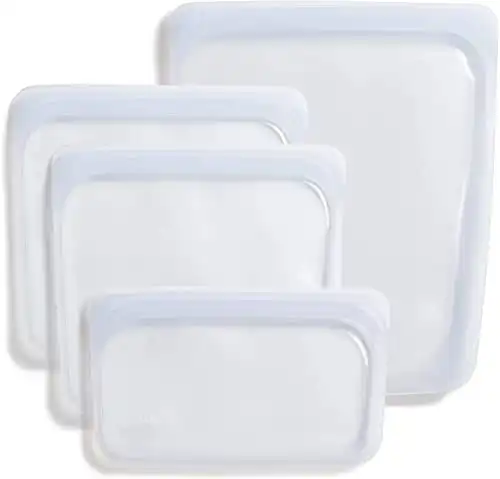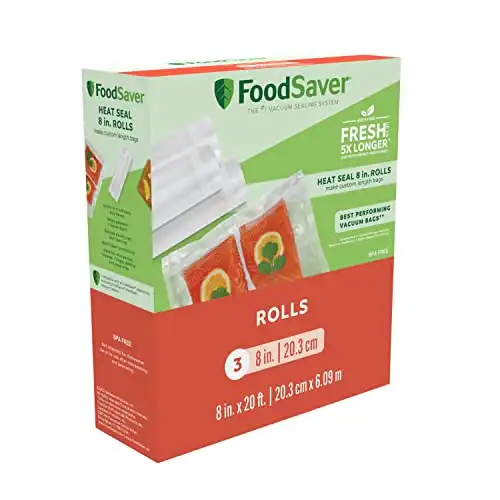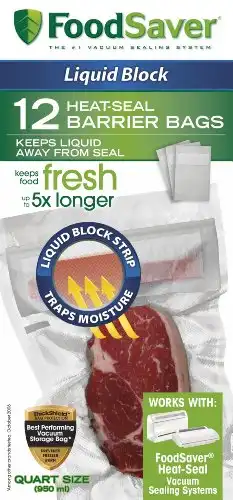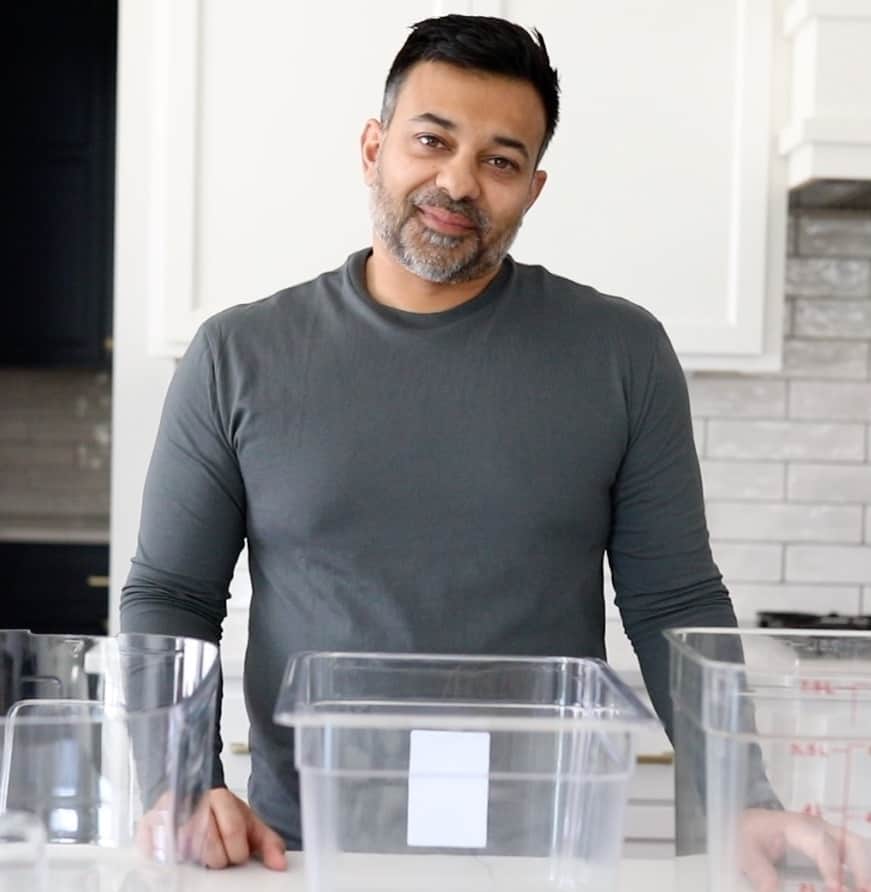As more of my friends and family taste the sous vide steaks and chicken that I make, they ask me more and more questions.
One of the most common questions I’m asked about sous vide isn’t about the best sous vide cooker, container, or even about cooking time and water temperature for different cuts of steak.
The most common question I’m asked is: What are the best bags for sous vide?
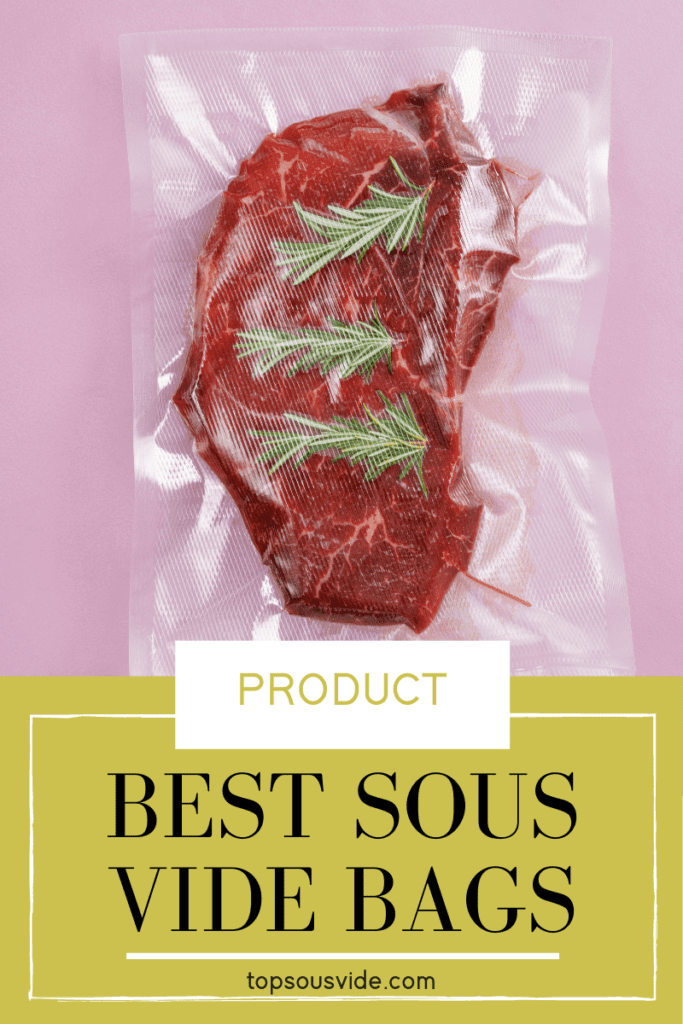
Top Sous Vide is a participant in the Amazon Services LLC Associates Program, an affiliate advertising program. This post may include affiliate links which means I may earn a small commission if you shop using the links below at no additional cost to you.
The best sous vide bags depend on the home chef, how they cook, what they want to cook, and what considerations are important to them.
Factors like size, ease of use, flexibility, costs, reusability, safety on long cooks, and more are taken into account. The best bags for me are the vacuum seal bag rolls paired with an automatic vacuum sealer.
I’m going to cover the best sous vide bags and the various types of bags there are. Bags will work with all sous vide cookers and sous vide containers, so no concerns with incompatibility.
There are three main categories of bags: Ziploc, Reusable Silicone, and Vacuum Seal.
Following the list of the best bags for sous vide is a buyer’s guide to help with your decision-making when buying bags. The guide will discuss all the different considerations to help you decide what the best bags are for you.
If you’re in a hurry, here are the best sous vide bags:
| Product Image | Product Name | Primary Button / Secondary Button |
|---|---|---|
Let’s get started with the best bags of each type.
Table of Contents
Ziploc Freezer Bags – Best Ziplock Bags
Ziploc freezer bags and storage bags are a great sous vide starter bag for the sous vide cooking method. Both these bags will work, although I prefer the freezer bags because they are thicker.
A thicker lining will allow the freezer bags to be more durable in a hot water bath. They’ll withstand the hours of heat from immersion circulators.
Ziploc also has zipper bags, so you can look to get those to more easily seal the bags. They are also BPA-free, so they’re food safe to use.
The best thing about Ziploc bags are that they’re readily available and at an affordable price. But if you want to cook anything for 6+ hours, I would avoid using a ziplock bag. Below is a link to the quart size Ziploc bags, which are suitable for a normal size chicken breast. Go to the gallon size Ziploc bags for larger items.
- Get unbeatable freezer protection with new Grip ‘n Seal technology
- Our triple system seal features an extended tab, new, easy grip texture and a double zipper
Stasher 100% Reusable Silicone Bags – Best Silicone Bags
The Stasher Platinum Silicone Bags are great for cooking sous vide style and are dishwasher and microwave safe. They’re self-sealing and relatively easy to use. There’s the added benefit of it being dishwasher-safe, but I’d still recommend hand washing as you’ll find out more in the buyer’s guide section.
I have a couple gripes with the Stasher sealed pouches. One is the thickness of the silicone that makes it a bigger pain to put a thick steak in or other meats.
The silicone also has a tough time removing all the air bubbles out of the reusable bags. You won’t get the tight wrap around your food like you will with ziplock or vacuum sealed bags.
With the air still there inside the bag, there’s the potential for the bags to float in the water when cooking. For food safety, it’s important to have the food pouch submerged or you won’t end up with fully cooked food.
You can use clips, weights, sous vide ping pong balls, stainless steel sous vide racks, and other things to help prevent floating. There’s less chance of floating with vacuum seal bags and zip lock bags because the air has already been pushed out of the food pouch.
- GO FROM LUNCH TO THE GYM: Waste-free storage for everything from snacks to sweats and sneakers, this assortment will take you through a busy day; BPA Free; Sandwich (15 Oz); Snack (9.9 Oz); 1/2 Gallon (64 Oz), Clear
- STORAGE FROM SOUP TO NUTS: Endless possibilities, organize the junk drawer, protect your cellphone & keys at the beach, pre-prep meals, freeze ingredients, pop in the microwave - Storage from herbs to 1st aid to baby wipes
Stasher Reusable Bag for Anova
Stasher and Anova have long partnered on the Stasher reusable bag for Anova, which is really just the half gallon size of Stasher bag co-branded. Anova has released it’s own silicone bag option, the Anova Precision Reusable Silicone Bag, which has both advantages and disadvantages against the regular Stasher bags.
The primary benefit of the Anova Precision Reusable Silicone Bag is that it is nearly 2 times larger than the the largest of Stasher bags, which opens up the possibility of cooking larger items like roasts. The closing mechanism is different in that you roll the top and use a pull tie to seal. This closing mechanism is a bit of a detriment in that users often complain it’s overly complicated.
We've designed this plastic-free bag to be totally food safe, provide an air tight seal, and it's even dishwasher safe for easy cleaning (top rack recommended).
Use this eco-friendly bag to make your favorite sous vide meals, bag up your leftovers for easy storage, and even reheat with your Anova the next day for that same delicious meal all over again.
FoodSaver Vacuum Seal Rolls – Best Vacuum Seal Bags
Vacuum sealed bags are my favorite types of sous vide bags. These FoodSaver Vacuum Seal Rolls go great with my FoodSaver vacuum sealer and offer the perfect solution for performance and safety.
They create the tightest wrap and seal around your food, to lessen the food risk of your food not being evenly cooked. This option also gives you the opportunity for huge savings when it comes to bag costs because you can buy rolls of the bag material to cut your per bag costs.
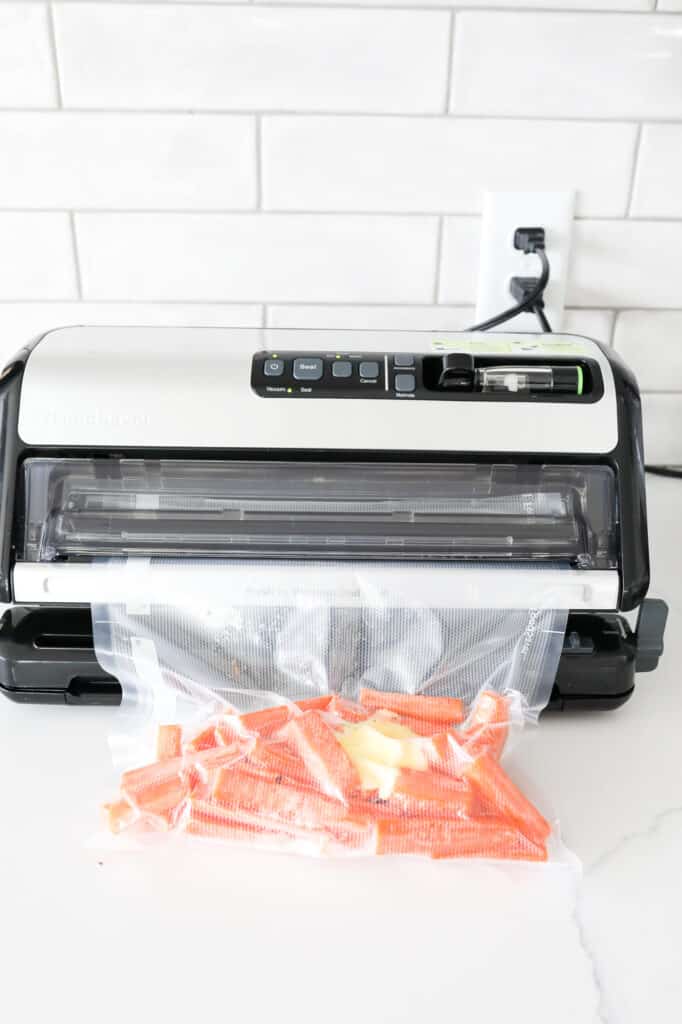
An airtight seal in the bags will also keep the food fresher if you decide to freeze your food later.
There are a couple vacuum sealing systems – Manual Hand Pump and Automatic Vacuum Sealer machines. The manual hand pumps will work like a ball and tire pump. The automatic vacuum sealer you just sit back and watch the machine seal.
Vacuum sealers will get you the airtight seals that you’re going to need to ensure no water gets in when cooking.
One note here with vacuum bags. If you have a FoodSaver vacuum sealer, be sure to buy FoodSaver bags for compatibility. Sometimes brands will not play well with other brands. Double-check your vacuum sealer machine and the vacuum seal bags if they’re not from the same company.
- FRESHNESS THAT LASTS FOR WEEKS, NOT DAYS: BPA-free multilayer design is constructed of durable yet pliable material that creates an airtight barrier around foods, extending freshness and locking in flavors
- CUSTOMIZE LENGTH TO FIT ANY FOOD YOU STORE: Having the option to cut the roll to whatever length you need means no more wasted material or precarious "doesn't quite fit" scenarios
Buying Guide for Sous Vide Bags
Let’s take a look at all the factors and considerations to look at so you have a good grasp of bags and how to choose the best ones for you.
Do You Need Special Bags for Sous Vide?
The basic premise of sous vide cooking is a vacuum-sealed bag submerged in water cooking at low temperatures for longer periods of time. This type of water immersion technique cooking method requires that sous vide foods are put into bags with a tight seal.
Using the right bags is absolutely necessary because that affects not just the taste and quality of your food, but also the safety of your food.
You need bags that are made to withstand the long cook times at certain temperatures. No melting bags please. You need bags that are sealed properly and won’t open when going into heated water. I prefer not to drink my steak.
What Types of Sous Vide Bags Are There?
There are three main types of bags: Ziplock, Silicone, and Vacuum Seal.
Ziplock Bags for Sous Vide
This is the fast and cheap option because we usually all have Ziploc bags lying around. These are popular choices, especially when starting out with sous vide cooking or when you happen to not have any other bags free.
When buying ziploc bags, you’ll want to get the ones that are microwave and freezer safe because they’re thicker and heavy duty. They’re ok to use when below 158°F / 70°C, but are not suitable for boiling water.
It’s possible to go higher for short periods of time, but you risk bursting seals. The seals will break open and your food will be waterlogged, along with dirty water.
You’ll need to employ the water displacement method sous vide when using Ziploc bags to get the air out of the bag. The pressure from the water as you lower the bag into the water will displace and push the air out of the bag. It doesn’t get all the air out like a vacuum sealer, but it will still work.
You could reuse the bags, but I wouldn’t reuse bags because each time you cook, the bags will break down, even if ever so slightly. There are some plastic bags meant to be reusable, but I haven’t tried them before.
While Ziploc bags are cheaper and not as reusable, the other side is the higher quality silicone.
Silicone Bags for Sous Vide
Silicone bags are more expensive, but they’re high quality, easier to clean, and reusable. Silicone bags are thicker and made of 100% pure platinum, food grade silicone that’s safe. They don’t contain the dangerous materials that plastics could have.
The biggest benefit with silicone bags is the reusability. You’re able to wash these reusable silicone bags in the dishwasher. I’d wash them by hand still because silicone bags aren’t as flexible and the dishwasher might not get deeper into the bag for a good clean.
Reusable silicone bags like the Stasher are also a bit tougher to get all the air out, especially if your food is curved (which is most food).
Another issue is a result of the thickness of the bags. It’s harder to flip and fold the bag’s mouth, to keep the bag’s seal clean when putting in food like raw chicken. Wiping it down with a paper towel isn’t a huge deal, but it’s another step that you’ll need to take.
Ziploc bags have a tough time withstanding high heat and silicone bags are stiffer to work with. Vacuum seal bags are a happy medium.
Vacuum Seal Bags for Sous Vide
Vacuum seal bags have several advantages and are a good combination of Ziploc bag and Silicone bag benefits. Vacuum sealed bags offer higher heat resistance, up to 195°F / 90°C (Ziploc bags are 158°F / 70°C). Vacuum sealed bags are also reusable, but easier to use and wash due to its flexibility.
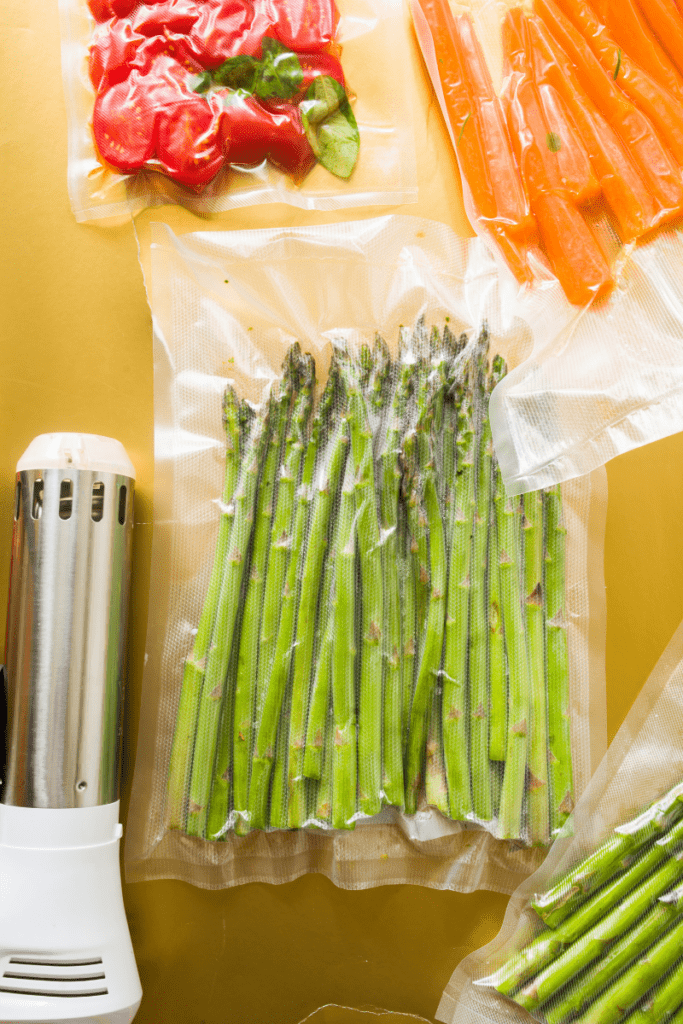
After you use a vacuum bag, you can wash it and reseal it. I’ll usually reuse bags until I’ve cut away too much to be able to reuse the bags again.
Vacuum Seal bags are also the perfect thickness to flip the edge of the bag as it’ll stay open wider for you to put in your food. Vacuum sealer bags aren’t as flimsy as some zip lock bags and not stiff like silicone bags.
With vacuum sealer bags, you have the option of different-sized pre-cut bags or large 8 or 11 inch heat seal rolls that give you the option to cut various bag sizes depending on the size and amount of your food. There’s no wasting of materials here.
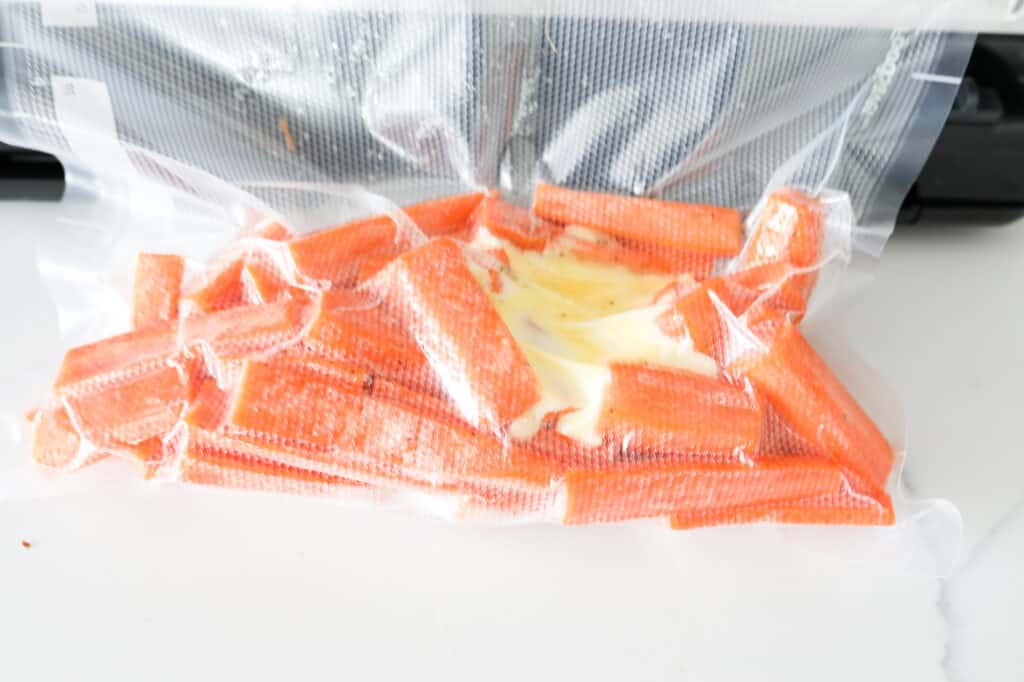
There are two different types of vacuum seal bags: embossed bags and smooth bags. Get the embossed bags as they’re the ones used for the majority of consumer vacuum sealers. The ridges in the bags help to get the air out. Smooth bags are usually used with chamber vacuum sealers.
Are Sous Vide Plastic Bags Safe?
Yes, plastic bags that are made specifically for sous vide use materials that are food grade safe. Keywords to look for when you’re looking at bags are:
Food Grade / Polyethylene
Microwave Safe and Freezer Safe are common words to look out for that brands will use on packaging. You want bags made of polyethylene as that’s been FDA-approved as food grade safe, meaning it can be exposed to food. Look for high-density polyethylene and low-density polyethylene bags/
That signals the materials used to make the plastic used on the bags will withstand high heat when cooking and low temperatures when stored in the fridge.
Even though sous vide cooking doesn’t go above boiling water at 100°C / 212°F, the sustained long exposure in heated water will still break down cheap plastic bags. It’s important to use plastic bags that won’t break, rip, or create holes when sous vide cooking, especially on long cooks.
BPA-Free
This is usually for hard plastics used in polycarbonate containers, but also an important thing to mention as we’re discussing plastic. Polycarbonate is the same materials that’s often used when making the reusable hard plastic water bottles.
If you ever begin to see cracks from the wear and tear of using and reusing the bottles or containers, be sure to stop using them. Throw them away and purchase a new one. Hazardous chemicals can leak out through the cracks and be ingested into your body.
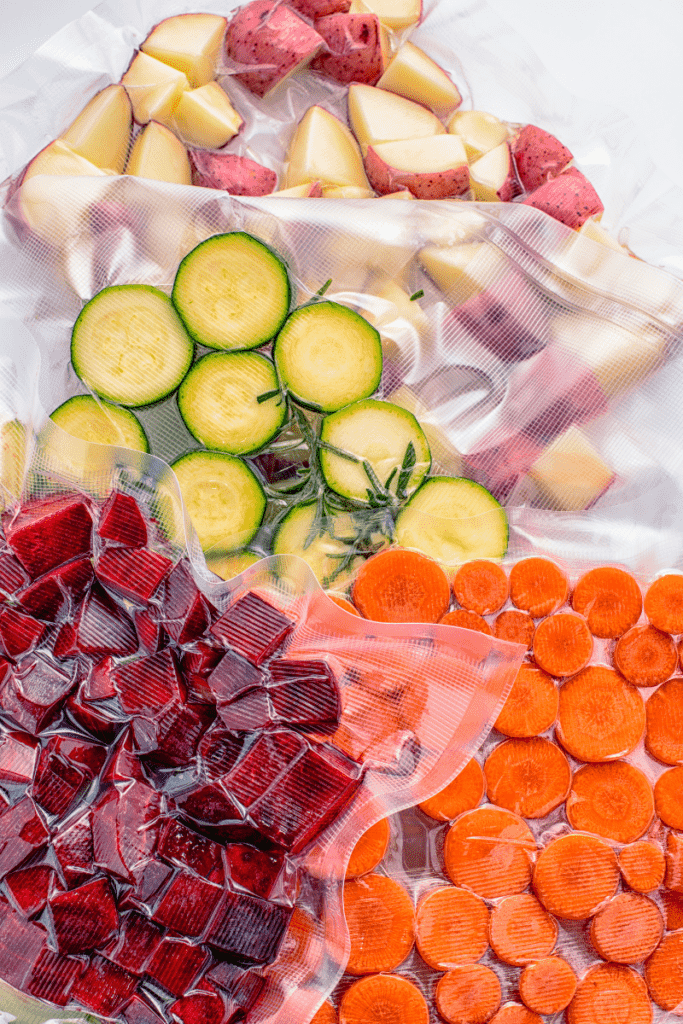
PVC (Polyvinyl Chloride)
DO NOT BUY PVC bags. Cheap, inexpensive, generic food bags are often made of this material. They’ll break down easily and chemicals will seep into your food.
How to Pick the Best Sous Vide Bags
These are the important considerations when choosing bags. I’m all about convenience, efficiency, and making sure my food is safe and won’t be ruined.
The main factors to consider when you’re deciding on the best sous vide bags for you:
- How much food?
- What do you like to eat?
- How often do you sous vide?
- What’s your budget?
1. How Much Food – Size and Quantity
I think we all know how many sized bags we have in the kitchen – a lot. We need snack bags, sandwich bags, half gallon bags, and of course full gallon sizes. A wide variety of food bags for a variety of different food items.
I use vacuum sealer bag rolls now because it minimizes the number of bags I used to have lying around for different sizes of food. I also don’t need to worry about the number of bags I have for a specific size.
If you’re not ready to go with a vacuum sealer yet, you’ll want to have different sized Ziploc bags on hand for different types of food.
2. What Type of Food Do You Cook
I love my marinated steaks, but that will often have lots of juices that could leak out when vacuum-sealing. I’ll use Liquids Block Bags like these by FoodSaver because they have a liquid-blocking strip near the bag’s opening to stop moisture and liquids from escaping. That helps to create a strong and clean seal, so water won’t get in when sous vide cooking.
- 12 heat-seel pre-cut quart sized bags
- Liquid-blocking strip prevents moisture from escaping bag and facilitates a strong, clean seal
If you’re going to be cooking for long periods of time and/or at temperatures above 158°F / 70°C, Do Not Use ziplock bags. Vacuum sealed bags are the best option for safety.
If your sous vide recipes call for a lower temperature under 158°F / 70°C, you can use Ziploc freezer bags. But vacuum sealer bags are still recommended, to be on the safe side.
3. What’s Your Sous Vide Cooking Process – Prep, Cook, Store Food
Sous vide enthusiasts may cook sous vide 4-5 times a week and if you’re cooking that many times, you’ll want to be sure your bags are affordable and of good quality. You don’t want to run the risk of not having food to eat because of a bag issue.
How often you cook sous vide will run into questions of how you buy, prep and store food as well. If you’re like me and will sometimes sous vide from frozen, you’ll need bags that are able to withstand the heat and cold to prevent freezer burn.
Costco and Sam’s Club are great places to buy things in bulk. They also offer great cuts of meat, so I do like to buy from there to save money and time. I’ll divide the food into smaller portions, vacuum seal the food, and put the bags in the freezer to keep the freshness.
When you have leftovers of cooked food, it’s also nice to have a reusable bag that you can put the leftovers in and cook again later. You’ll be able to use a silicone or vacuum sealer bag for food storage.
4. What’s Your Budget – Reusability, Automation, Convenience
Ziplock bags are the cheapest way to go. If you cook a lot and don’t mind thoroughly hand cleaning silicone bags, you’ll have fewer costs per-use because you can reuse the silicone bags over and over again.
If you’re able to spend $70-200, get a good vacuum sealer because vacuum seal bags give you the most flexibility, safety, and are easier to use.
The FoodSaver V4840 2-in-1 Vacuum Sealer is the one I use as it will store and cut the roll, so no need to store the roll separately nor need scissors.
For a lower cost option, the FoodSaver V2244 Vacuum Sealer and Geryon are both good options. It does what it’s supposed to without any of the frills. You can start out with this as an option and then upgrade later when your sous vide cooking skills expand. FoodSaver is well known for their vacuum sealers and food storage bags.
Once you become a professional chef with your own small scale restaurant, you can upgrade to a chamber vacuum sealer. Those will run from $500 to $1000+. Restaurants use chamber vacuum sealers because they do the best job of sucking all the air out, so they’re best for commercial use.
Find the 11 best vacuum sealers here!
FAQs Frequently Asked Questions
Plastic and silicone are the main materials used to make sous vide bags. They can come in the form of a ziplock, silicone, or vacuum seal bag.
Vacuum seal bags have the best benefits of both ziplock and silicone bags, but will require a budget to purchase a vacuum sealer.
There are a couple main differences between plastic ziplock and silicone bags. Ziplock bags are not meant to be reusable and should only be used when cooking under 158°F / 70°C. Silicone bags are made for reuse and sous vide cooking temperatures and cooking times.
Yes, ziplock bags can melt if the temperature is high enough, like in boiling water. But with sous vide, you won’t be using boiling water. As long as you keep the temperature under 158°F / 70°C, they shouldn’t melt.
No, don’t use saran wrap, cling wrap, or any other plastic wrap as a sous vide bag. You can use saran wrap to cover the top of your cooking vessel if you don’t have tailored lids or sous vide balls for your immersion circulator, but definitely don’t use the saran wrap as a bag.
You’ll have leakage and potential saran wrap chemicals seeping into your food.
Online marketplaces like Amazon, Walmart, or Target are the best places to buy bags. I prefer the convenience of Amazon and fast shipping with Amazon Prime. Anova Culinary has partnered with Stasher to sell premium reusable, silicone bags.
Yes, they actually are! There are recycling centers and retail stores that will accept plastic bags for recycling. Visit Plastic Film Recycling and put in your location to see the nearest recycling centers for you to drop off your plastic.
Reusable silicone bags can be put in the dishwasher or hand washed. I’d hand wash it to make sure you’re able to wash all the insides. Depending on your bag, there could be areas that your dishwasher won’t hit and bacteria will grow there.
Vacuum seal bags can be hand washed. Ziplock bags should be thrown away or recycled. The cooking might have weakened the bag’s plastic and seams, so there’s more risk potential.
There are glass canning jars that you can sous vide in to make your own Starbucks sous vide egg bites, custards, pates, and various other desserts.
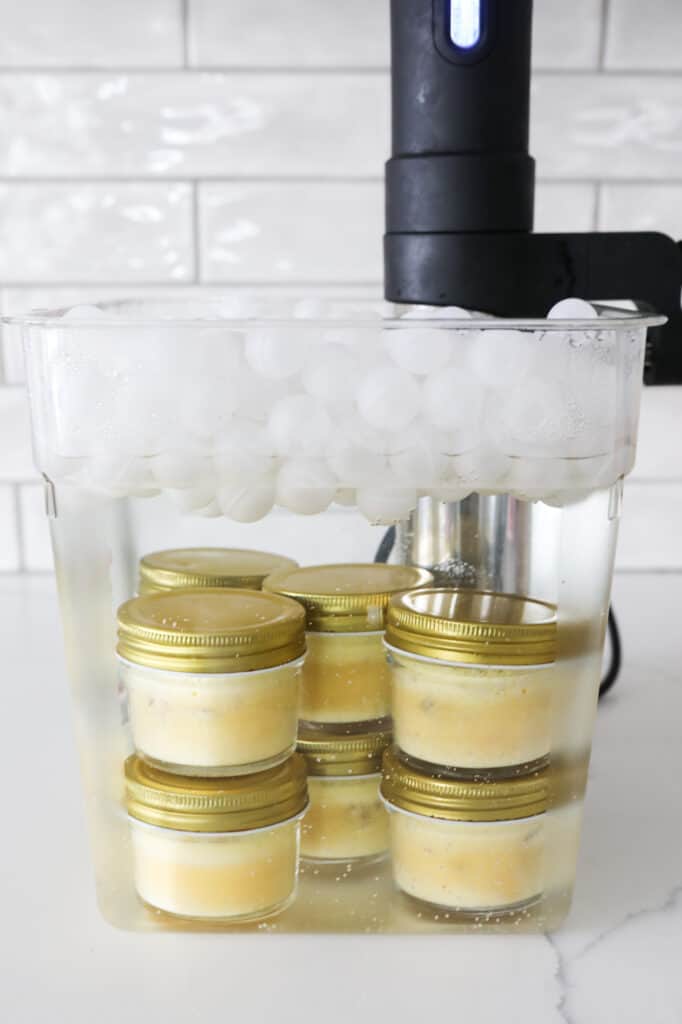
If you want more, check out the 11 best vacuum sealers here!

